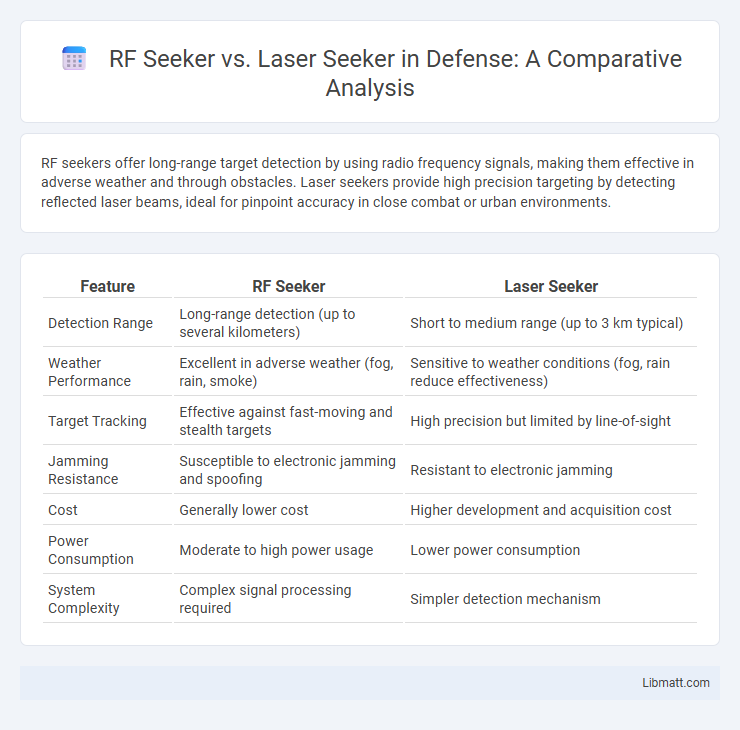RF seekers offer long-range target detection by using radio frequency signals, making them effective in adverse weather and through obstacles. Laser seekers provide high precision targeting by detecting reflected laser beams, ideal for pinpoint accuracy in close combat or urban environments.
Table of Comparison
| Feature | RF Seeker | Laser Seeker |
|---|---|---|
| Detection Range | Long-range detection (up to several kilometers) | Short to medium range (up to 3 km typical) |
| Weather Performance | Excellent in adverse weather (fog, rain, smoke) | Sensitive to weather conditions (fog, rain reduce effectiveness) |
| Target Tracking | Effective against fast-moving and stealth targets | High precision but limited by line-of-sight |
| Jamming Resistance | Susceptible to electronic jamming and spoofing | Resistant to electronic jamming |
| Cost | Generally lower cost | Higher development and acquisition cost |
| Power Consumption | Moderate to high power usage | Lower power consumption |
| System Complexity | Complex signal processing required | Simpler detection mechanism |
Introduction to RF and Laser Seekers
RF seekers use radio frequency signals to detect and track targets over long distances, offering all-weather, day-and-night operational capabilities. Laser seekers rely on reflected laser beams to provide highly accurate and precise targeting, though their effectiveness can be reduced by fog, smoke, or heavy precipitation. Both technologies serve distinct roles in missile guidance systems, balancing detection range and targeting precision.
Core Technologies Explained
RF seekers utilize radio frequency waves to detect and track targets by analyzing signal reflections, benefiting from all-weather and long-range capabilities. Laser seekers depend on reflected laser energy, offering higher precision and resistance to electronic countermeasures, but typically require clear line-of-sight conditions. Core technologies in RF seekers involve radar signal processing and Doppler effect measurements, while laser seekers rely on laser diode emitters, photodetectors, and optical filtering systems.
Key Differences Between RF and Laser Seekers
RF seekers utilize radio frequency signals to detect and track targets by analyzing emitted or reflected electromagnetic waves, offering all-weather and long-range capabilities. Laser seekers rely on reflected laser energy to provide precise, high-resolution target imaging, which is highly accurate but may be affected by environmental conditions such as fog or smoke. Your choice between RF and laser seekers depends on the mission requirements for range, accuracy, and environmental resilience.
Applications in Modern Warfare
RF seekers excel in long-range target detection and tracking, making them ideal for missile guidance against moving vehicles and aircraft in electronic warfare environments. Laser seekers provide high-precision targeting, especially effective in close-range combat scenarios and environments requiring minimal electronic interference. Your choice between RF and laser seekers should align with mission-specific requirements, such as range, target type, and susceptibility to countermeasures.
Advantages of RF Seekers
RF seekers offer superior all-weather capability, effectively detecting targets through smoke, fog, and dust where laser seekers may fail. They provide longer detection ranges and better resistance to countermeasures, enhancing missile guidance reliability. RF seekers' ability to penetrate obscurants and maintain target lock makes them advantageous for diverse combat environments.
Advantages of Laser Seekers
Laser seekers offer highly precise target acquisition and tracking capabilities, enabling accurate guidance even in complex environments with minimal signal interference. They provide superior resistance to electronic countermeasures compared to RF seekers, ensuring reliable performance in contested electromagnetic spectrums. Their ability to deliver high-resolution targeting data enhances missile effectiveness against fast-moving or low-observable targets.
Limitations and Vulnerabilities
RF seekers face limitations in environments dense with electronic countermeasures, as jamming and signal interference can degrade their tracking accuracy. Laser seekers are vulnerable to adverse weather conditions like fog, smoke, and dust, which scatter or absorb the laser beam, reducing targeting effectiveness. Both systems exhibit weaknesses: RF seekers can be deceived by stealth technologies and decoys, while laser seekers are susceptible to blinding or dazzling countermeasures and require line-of-sight for optimal operation.
Cost and Deployment Considerations
RF seekers generally have higher initial costs due to complex electronic components but offer greater all-weather deployment capabilities and longer detection ranges compared to laser seekers. Laser seekers tend to be more cost-effective and lighter, allowing for easier integration on smaller platforms, but are limited by line-of-sight requirements and reduced effectiveness in adverse weather conditions. Your choice depends on balancing budget constraints with operational needs, such as deployment environment and target engagement scenarios.
Recent Innovations and Trends
Recent innovations in RF seeker technology emphasize enhanced signal processing algorithms and adaptive filtering techniques, significantly improving target detection and jamming resistance. Laser seekers have seen advancements in beam steering and wavelength agility, allowing for higher precision targeting under challenging weather conditions. Integration of AI and sensor fusion is a growing trend, boosting the overall accuracy and reliability of both RF and Laser seeker systems in modern missile guidance.
Future Outlook for Seeker Technologies
RF seekers are evolving with advancements in digital beamforming and cognitive radar, enhancing target detection and resistance to countermeasures for next-generation missile systems. Laser seekers continue to improve in precision targeting and miniaturization, enabling superior accuracy in complex environments and urban warfare scenarios. Your tactical advantage will increase as integrated seeker technologies combine RF and laser capabilities for multi-spectral targeting and enhanced situational awareness.
RF seeker vs Laser seeker Infographic

 libmatt.com
libmatt.com